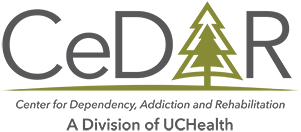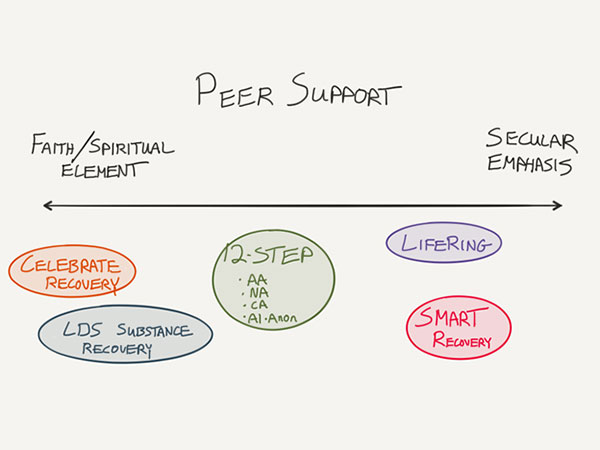PEER SUPPORT
Many people engage in peer support programs to bolster their recovery. They enjoy the fellowship and guidance from others’ experiences and like to work a structured program. Most embrace the self-reflective nature of something like 12-Step. At the same time, many people are against peer support options. These people often cite something about the historical faith components of Alcoholic’s Anonymous.
To discuss this further, we need to acknowledge there are other available peer support modalities in addition to AA. These can differ in how they approach themes of spirituality in addiction recovery. This diagram places some of the most commonly used peer support modalities based on faith and spiritual emphasis.
Alcoholics Anonymous and 12-Step
The original peer support program was Alcoholics Anonymous, founded in 1935. The goals of the program are to provide a safe space for alcoholics to connect. Here they problem-solve recovery and learn from each other. Many of the members of AA had tried other forms of treatment including psychotherapy. They felt that the only way to fully heal from the disease of alcoholism was to collaborate and hold each other accountable.
The founders of AA developed it on a Christian tradition. There is language in many of the AA writings which refer to concepts of God and a Higher Power. For many people, this can be a turnoff from involvement in AA. The majority of AA participants (about two-thirds) actually define themselves as agnostic or disinterested in faith and religion. Even so, the central Christian messages can be difficult for some people.
It is important to acknowledge the ingredients present in a program like AA on a deeper level. That way you could decide if it could offer you something for your own spirituality in addiction recovery.
Positive Ingredients of AA
- Safe space to actively discuss alcoholism
- No cost
- Highly accessible – Over 100,000 groups worldwide
- High volume – Close to 2 million current members
- Provides connection for working with a sponsor
Negative Ingredients of AA
- No licensed professional structure – people just give their opinions
- Conflicting medical evidence – difficult to study well in clinical science
- “13th step issues” – people using meetings to date or hook-up with new members
- Some past conflict with psychiatry – anti-medication stances have been historically part of AA
- Time-consuming – recommendations to start AA involve attend 90 meetings in 90 days
Overall, active involvement with AA and working steps with a sponsor has a strong effect size for alcoholism recovery. Different demographic groups show somewhat different results though, such as questionable problems for young-people attending AA and getting exposure to drug use from other addicts. The attrition rate for AA is quite high (up to 95% drop-out rate) and this raises the question of AA as a viable referral for people with a chronic disease. AA does acknowledge this dilemma and potential benefit through its common quote:
“The Program works if you Work It!”
‘Secular’ Emphasis Peer Support Programs – LifeRing and SMART Recovery
Each of these programs has developed over the past few decades as somewhat alternatives to 12-step options. SMART Recovery was developed in the early 1990’s by an advocacy group called the Alcohol and Drug Abuse Self-Help Network (ADASHN). This program emphasized understanding the stages of change to heal from addiction, cognitive behavioral therapy themes to help people cope with cravings, and an emphasis on engagement and nonconfrontational approaches to healing. There are over 1500 current SMART Recovery meetings available throughout the world today.
LifeRing is a very close alternative to 12-Step that makes a conscious effort to avoid the concepts of a Higher Power, spiritual awakening, or prayer connected to meetings. It emphasizes the peer community to help your healing and also the theme of ‘do what works.’ LifeRing has developed in connection with some common psychotherapy modalities, specifically drawing from CBT in a similar way as SMART Recovery. There are currently more than 150 LifeRing meetings available for people around the world.
Faith-Based Recovery Programs – Celebrate Recovery and LDS Addiction Recovery Program
On the other side of the spectrum lies more faith-based peer support programs. These mainly include Celebrate Recovery, which is a Christian-based peer support program run through approximately 29,000 churches today, and the LDS Addiction Recovery Program, developed through the Mormon Church to offer structured recovery options to patrons struggling with spirituality in addiction recovery.
Each of these programs strongly emphasizes the role of God in recovery, whereas 12-Step uses more of an abstract concept of a Higher Power. Because of the scope of the Celebrate Recovery program, there are many people who enroll in it who do not struggle with an addictive disorder but instead wish to heal from other ‘hang-ups’ in life. This program also uses a stepwise approach to promote similar concepts as 12-Step, namely acceptance, surrender, commitment to health, and service to others.
Final Thoughts
The most important ingredient present in all peer support programs, no matter where they fall on the spectrum of faith, is that of communication with another person. Overall, these programs provide benefit to people through collaboration, trust, and the principle of positive identification:
“This person is similar to me in life and also developed an addiction. This person also healed from that addiction as I intend to do!”
Many treatment centers introduce 12-Step modalities for our peer support curriculum. Some of this is simply based on mass-effect: 100,000 AA groups as compared to 150 LifeRing groups. It’s important to assist people in engaging in programming which they can maintain for years to come.
Sometimes the discussions around spirituality in addiction recovery and faith actually are more about such ambivalence. It’s important to observe responses to get a sense of open or close-mindedness. For example, it is common to encourage a person to attend an AA meeting, only to have them decline that option due to the mention of a Higher Power. Then, when offering an alternative such as SMART Recovery, they say they’re worried about too much time being spent away from their family. This is seen as resistance in the process.
A program may not fit you perfectly well, but the willingness to try one of these demonstrates true motivation to change. Resistance to using peer support is common, but make sure that the resistance is not a deeper resistance to recovery overall.





